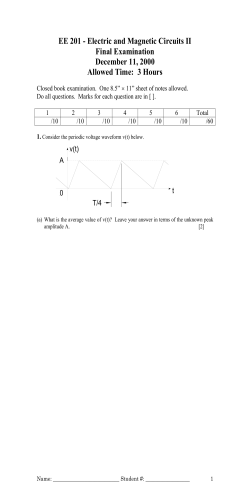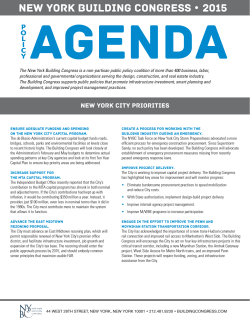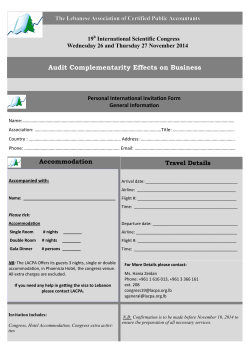
71WFC Presentation
71st World Foundry Congress. Bilbao 2014 New induction wireless efficient manufacturing process for furnaces J.L. Villa, C. Cortés, J.F. Sanz, A. Carrión, M. Ons CIRCE Foundation, Zaragoza, Spain 71st World Foundry Congress. Bilbao 2014 Demonstration of a new production process able to decrease the embodied energy of the foundry products by over 25%, reducing drastically its carbon footprint “This project has received funding from the European Union’s Seventh Programme for research, technological development and demonstration under grant agreement Nº 296024” 1 71st World Foundry Congress. Bilbao 2014 More flexibility, less emissions and more energy efficiency within the whole plant “This project has received funding from the European Union’s Seventh Programme for research, technological development and demonstration under grant agreement Nº 296024” 1 71st World Foundry Congress. Bilbao 2014 Sectors tackled: Energy Intensive Industries ( Aluminium, Iron Steel foundry Most of the energy consumed by these furnaces is used to heat the raw materials up to the corresponding melting points (from ~700°C for an aluminium furnace to ~1450°C for Iron furnace and 1650ºC for Steel furnace). From this energy used during the heating process, up to 50% is lost via heat transfers and gas waste. Expected Results and activities • Recommendations for new processes and equipment • New integral design of processes, materials and equipment through simulation • New detailed concept and methodology for manufacturing processes in the metallurgical industry • Three furnaces prototypes to be constructed and tested i • Operation guides for the new processes and equipment • Definition of new production models “This project has received funding from the European Union’s Seventh Programme for research, technological development and demonstration under grant agreement Nº 296024” 1 71st World Foundry Congress. Bilbao 2014 IPT SYSTEM OPERATION An IPT (Inductive Power Transfer) consist of two coils separated through the air by a defined distance. The system works as a transformer but in this case without iron core 1 71st World Foundry Congress. Bilbao 2014 IPT SYSTEM OPERATION The transferred power depends on: • • • • • M: Mutual inductance coefficient ( geometry, size and section of coils) ω: Operation frequency. This frequency must ensure that the coils are in resonance and achieve the highest power transfer with the optimal grid consumption. Ip: Primary current. Is set depending the power and the voltage of the grid RL: Resistance of the furnace. Qs: Quality factor. Is the increase in power achieved tuning the secondary coil trough capacitors in both coils 7 71st World Foundry Congress. Bilbao 2014 A 100 kW IPT system has been designed to fed an aluminum furnace. The final design consists of two round coils with a average radius of 250 mm, separated 30 mm The theoretical efficiency is around 98 %, but in fact with the system built and taken into account the power electronic losses, the real efficiency of the whole system won’t be higher than 85 % 2 71st World Foundry Congress. Bilbao 2014 According to the current regulatory framework (ICNIRP-2010), the maximum occupational public exposure to magnetic fields allowed at the operation frequency (20 kHz) is 100 µT. Therefore, a shielding for the IPT is mandatory to protect the workers . An aluminum box keep the magnetic field inside. Figure 3 shows the magnetic field above 100 mT in red 3 71st World Foundry Congress. Bilbao 2014 AIR COOLING CONFIGURATIONS In order to evacuate the thermal load by means of forced convection heat transfer, it is necessary some perforations in the aluminium box to make possible an air current to cross the geometry and cool the electric parts inside the box. The maximum temperature reached in the centre of the coils is around 70ºC (158 ºF), lower than the critical point defined at 100ºC (212 ºF) that would induce damage in the insulation of the coils. 5 71st World Foundry Congress. Bilbao 2014 CROSSED FLOW As a first approach it is also feasible that a forced air flowing with a speed of more than 7 m/s can keep the temperature of the ferrite and the solenoids along the time below required thresholds WATER COOLING CONFIGURATIONS To avoid the deposition of dust inside the boxes, the space is filled with a solid composite made of a non-metallic material so that it does not affect the magnetic field distribution and performance of the system. • Using water instead of air allows to greatly enhance heat transfer at a reasonable cost • It will be possible to avoid dust deposition on free surfaces on it. 6 71st World Foundry Congress. Bilbao 2014 Thank you for your attention and your comments Contacts Dr. Juan Luis Villa: [email protected] CIRCE Foundation +34 976 762 619 www.fcirce.es Project NIWE Contacts: Project Coordinator: Dr. José Carlos García+34 943 10 51 15 [email protected] Dissemination manager: José Luis Vadillo +34 672 33 40 85 [email protected]
© Copyright 2025









